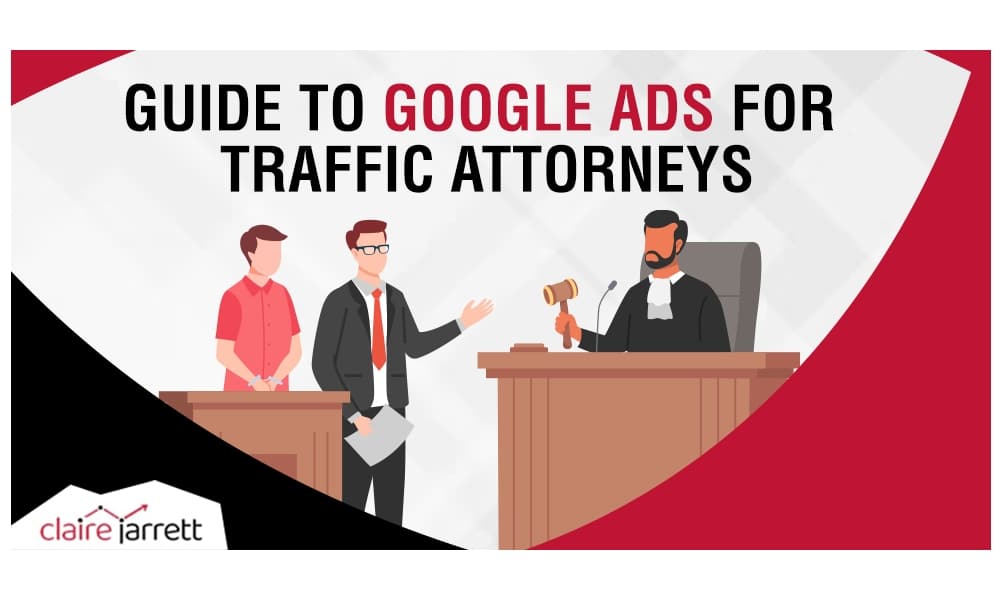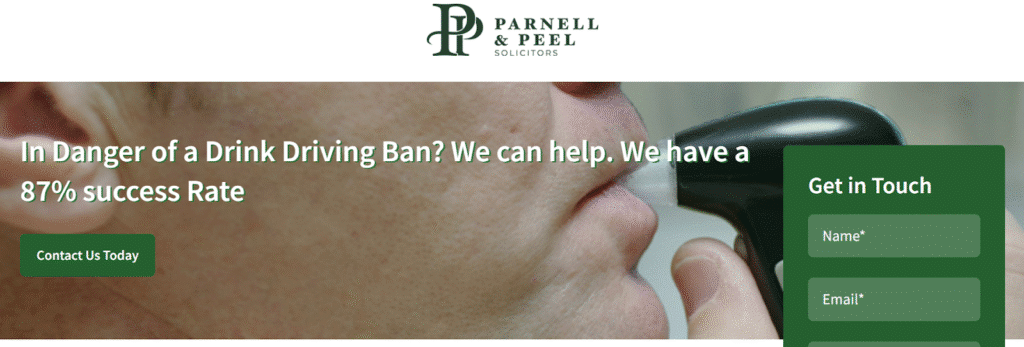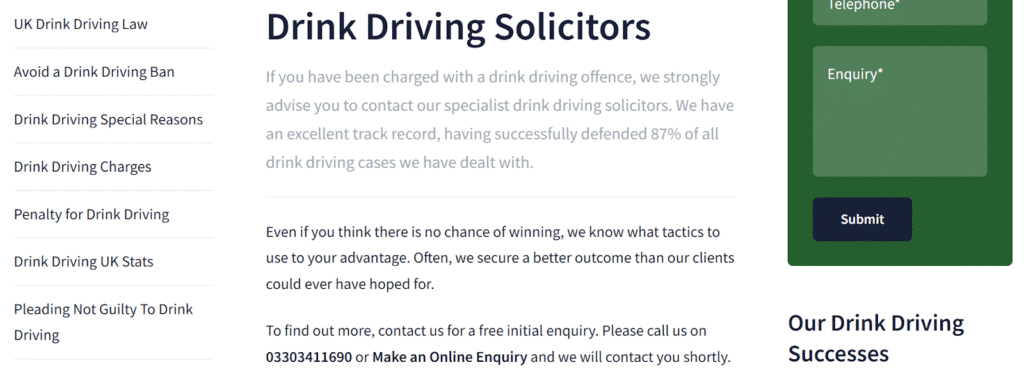Google Ads for Traffic Attorneys

Last Updated on: 12th September 2025, 11:06 am
When you’re using Google Ads for traffic attorneys, the searcher’s first impression often decides who gets the call.
It’s rarely about who has the slickest brochure. Rather, it’s about who shows up right then, at the top of the search results, when someone types in their frantic traffic law search.
But just appearing isn’t enough. In this guide, I’ll show you how to run Google Ads for traffic attorneys that will consistently bring in qualified, high-value cases.
First, Understand What’s Urgent and Stick to It in Your Google Ads for Traffic Attorneys
Every traffic case has its own weight. Some drivers want to avoid a small fine. For others (like delivery drivers, taxi operators, or those with prior offences), a penalty feels like the walls closing in.
So before you start cherry-picking keywords or writing ads, clarify which kinds of cases and drivers you want to help:
- Do you want volume, as in lots of minor speeding enquiries?
- Or higher-value representation for more serious charges?
- Are you prepared to answer calls after hours if you advertise 24/7 help?
Your campaign strategy in Google Ads for traffic attorneys should be built around these decisions, not tacked on as a post-launch afterthought.
Start Engineering Your Budget
More Google Ads spend doesn’t mean better cases. Instead of obsessing over “How much should I spend?” start by asking:
- What’s a client worth to you? If defending a DUI charge brings in $2,500 on average, that’s your baseline.
- How many of those cases do you have the capacity to take on monthly?
- What’s your threshold for risk? Some law firms are comfortable investing aggressively from day one. Others prefer easing in with a modest daily budget and scaling as the data improves.
From there, work out your range:
If your cost per click (CPC) hovers between $15-$40 (which is common in traffic law), and your landing page converts 1 in 20 clicks to a qualified enquiry, you can reverse-engineer your cost.
For example, your calculations in Google Ads for traffic attorneys might look something like this:
- 20 clicks to get 1 lead
- You want 20 new clients a month
- Your close rate is 25%
You’d need around 80 leads, or ~1,600 clicks to get 20 new clients every month.
To Make Your Budget Go the Extra Mile, Focus on Your Ideal Clients
With Google Ads, you don’t necessarily just want to focus on the urgent (but small) cases.
Instead, think about your biggest cases so far, weighing the complexity against the financial gain, and prepare to focus your targeting on them. After all, if you pay $30 for a click that will convert into a $10,000+ payout, you’ll achieve higher Return on Ad Spend.
Campaign Setup: Put Precision Over Popularity
If you want qualified calls, don’t try to be all things to all people.
Even if you operate a big firm with specialists in everything from traffic and criminal defence to divorce law, avoid mixing practice areas. It confuses both Google and your prospects.
That clarity starts with the right campaign type. One built to match intent precisely, not scatter it.
Search Campaigns: Your Most Reliable Channel in Google Ads for Traffic Attorneys
Search campaigns are the cornerstone of most successful traffic practices for one reason: urgency. People get a court notice or a fine, and within hours, they’re searching:
- “solicitor for driving offence near me”
- “legal advice contest drink driving ban”
- “traffic attorney same day consultation”
These are active requests for help, often with a deadline attached.
Keep your campaign structure lean:
- Separate campaigns for your highest-value services (e.g., drunk-driving defence vs. general speeding fines)
- Create clear, service-specific ad groups so your messaging always matches what the person searched for
- Use location targeting so you only pay for clicks you can service
That’s how you protect your spend from being drained by irrelevant queries and low-intent clicks.
Only Pay for the Right Eyes with Geographic Targeting and Scheduling
Every click you pay for should have a real chance of becoming a client, instead of someone 200 miles away who hits the back button when they realise you’re out of reach.
Location Targeting
If you only defend cases in your city or county courts, set your radius accordingly. Even better, mention your service area directly in your headlines (“Serving all of Essex traffic courts”) so there’s no ambiguity.
Ad Scheduling
Think about when you answer your phone. If you have an on-call number for police station representation, your ads can run 24/7. But if your team clocks off at 5 pm, there’s no point wasting budget on midnight clicks that go straight to voicemail.
Use Real Keyword Searches to Build Your Messaging in Google Ads for Traffic Attorneys
Many traffic clients don’t know the official term for what they’re facing. They’ll type whatever it is they can comprehend about the situation, hoping Google can fill in the gaps.
(Mind you, as the founder of a PPC agency for lawyers, I see this happening across practice areas – from family law to bankruptcy law. It’s not just you. But you do have to be mindful of it when running ads.)
For example:
- “help with speeding fine”
- “drink driving attorney near me”
“driving ban advice urgent”
And yes, keywords still matter. Google’s automation is powerful, but it still relies on you giving it the right signals. Keywords are how you steer the ship, and without them, you’re just letting Google drift wherever it likes (usually toward your budget evaporating).
How to Build a Great Keyword List for Google Ads for Traffic Attorneys
- Start with real searches. Use tools like SEMrush or SpyFu to see exactly what people are typing and what those clicks cost.
- Group by intent. Someone trying to contest a fine isn’t the same as someone facing a ban. Different keywords, different ads, different landing pages.
- Stay vigilant with negative keywords. Terms like “free legal advice” or “citizens advice speeding ticket” can drain your budget without delivering paying clients.
- Write like a human. Your keywords get you in front of the right person, but your ads and landing pages need to sound like an experienced solicitor who understands what’s at stake, not someone repeating the search phrase for the sake of it.
If you take one thing away: keywords are still your first lever of control. Automations and AI help, but you need to show Google who you want to hear from, as well as who you don’t.
Bidding (or Where Good Intentions Meet Your Wallet)
Instead of picking a law firm advertising strategy because it “sounds advanced,” think about how much control you want and how much data you have.
Here’s how to weigh your options:
- Manual CPC: You pick exactly how much to bid on each keyword. Perfect if you want granular control and have time to check in weekly or more. However, it drains your time, so it’s best used when working with a Google Ads management service.
- Enhanced CPC: A little automation, a little control. You still set a base bid, but Google can nudge it up or down if it thinks a click is more likely to convert. This can work well once you’ve got a few dozen conversions logged, but watch your averages as costs can creep up if you’re not paying attention.
- Target CPA: The fully automated option where Google tries to get you conversions at your target cost per lead. This can be fantastic if you have a healthy stream of conversion data and consistent call tracking. If you don’t, work with a seasoned Google Ads coach.
Whichever you choose, pair it with exclusions and location filters. Automation without boundaries is a recipe for waste – especially in traffic law, where leads can be unpredictable and low-intent clicks are plentiful.
Craft Ads That Calm Nerves and Persuade
Your prospective client is worried and probably embarrassed. So your ad copy needs to convey both authority and empathy with the following elements:
- A clear call to action: “Call now for immediate advice.”
- Reassurance: “Over 1,000 traffic cases defended.”
- Urgency: “Same-day representation available.”
- Trust signals: “Highly-rated traffic solicitors.”
Look at how this ad does the job without wasting a pixel of space:
- Direct headline. Let Us Save Your Licence Today doesn’t dance around the issue. It states exactly what they’ll help you do, in plain English.
- Proof you can trust. 87% Success Rate. In legal advertising, specifics build more credibility than any tagline.
- Multiple prompts to act. You’re never left wondering how to get help: Send Us Your Free Driving Enquiry. Call Us To Know Your Rights. Every line is a nudge forward.
- Reassurance without the hard sell. We Are On Your Side. That’s the line that makes people feel they’ve found an ally beyond a law firm.
- Outcome-focused clarity. Retain The Right To Drive. It spells out exactly what’s at stake and what you’re fighting for.
- Simple promise. Simple, Honest Advice. Here’s a clear commitment to guide them through.
This is a smart example because it combines urgency, proof, and clear direction. If your ads don’t make it obvious why you’re the safest pair of hands and what happens next, start here.
Make Sure Your Landing Pages Keep Your Ad’s Promise
When someone’s staring down a driving ban, you get one chance to prove you know exactly what they’re up against – and that you’re ready to help today, not next week.
Here’s how to build a landing page that reels them in:
- Headline that matches the ad, word for word if possible. If your ad says “Help Contest Speeding Fines,” your headline should too. That instant recognition is what calms people down enough to pick up the phone.
- Specific benefits, always. “Experienced traffic solicitor. 1,200+ cases defended. Fixed fees available.” beats “We care about our clients.” every time.
- Contact options you can’t miss. Big phone number (click-to-call on mobile), a short form, maybe even live chat if you have it. If someone’s panicking, they shouldn’t have to hunt around for how to reach you.
- Evidence you’re credible. A testimonial about a successful case (if permitted), badges from relevant associations, or a short case study can go a long way to build trust.
- Fast, mobile-friendly layout. Remember, most traffic clients are searching on their phones, often minutes after getting pulled over. If your site loads slowly or looks clunky, they’ll bounce.
For example, this drunk-driving landing page (from the ad we’ve analysed earlier) is another strong example of focus and flow. Take note:
Above the fold (the hero section):
- They lead with a direct, emotional headline: In Danger of a Drink Driving Ban? We can help.
- They immediately offer social proof: 87% success rate.
- The Contact Us Today button is clear and prominent, as well as the contact form on the sidebar.
Below the fold (body copy):
- They expand on reassurance: explaining tactics, sharing outcomes, and breaking down the process.
- They use plain language rather than legal jargon.
- All doubts are addressed in clear, scannable sections like penalties, defences, and what happens next.
If someone isn’t convinced by the headline alone, this body copy quietly closes the gap. It doesn’t rely on hype; it calmly demonstrates authority and empathy.
When you combine an ad that filters and attracts the right cases with a landing page that picks up the conversation seamlessly, you remove almost every obstacle to action.
Measuring Only the Necessary in Google Ads for Traffic Attorneys
Google Ads for traffic attorneys demands active oversight. If you’re not reviewing your results regularly, you’re leaving your budget exposed.
Focus on these core checks every week, or work with a PPC consultant to continuously optimise your campaigns:
- Conversion tracking: Confirm your tags are recording calls and form submissions accurately. Use Tag Assistant to validate the setup.
- Call recordings and logs: Listen to sample calls. Are they genuine enquiries about defending licences or just people looking for free guidance?
- Search term reports: Review the real search queries triggering your ads. If you see irrelevant terms like “legal aid solicitor,” and that’s not your market, add them to your negative keyword list straight away.
- Landing page engagement: Check bounce rates and time on page in Google Analytics. If visitors leave within a few seconds, something isn’t working, regardless of whether it’s slow loading, confusing content, or a lack of clear next steps.
The Road Ahead
No one plans for a speeding summons or a DUI charge. They land in crisis mode with no idea where to turn. A Google Ads campaign earns its keep by placing you in front of the right person at the right time with a message that feels reassuring rather than salesy.
If you’re ready to build a system that consistently brings in qualified traffic cases – and you’d like a roadmap grounded in experience rather than trial and error – Rapid Google Ads Success for Lawyers will show you exactly how. And if you prefer a more hands-on approach, with expert eyes on every step, just get in touch. I’ll build a system that works in your favour when the next ideal search appears!




